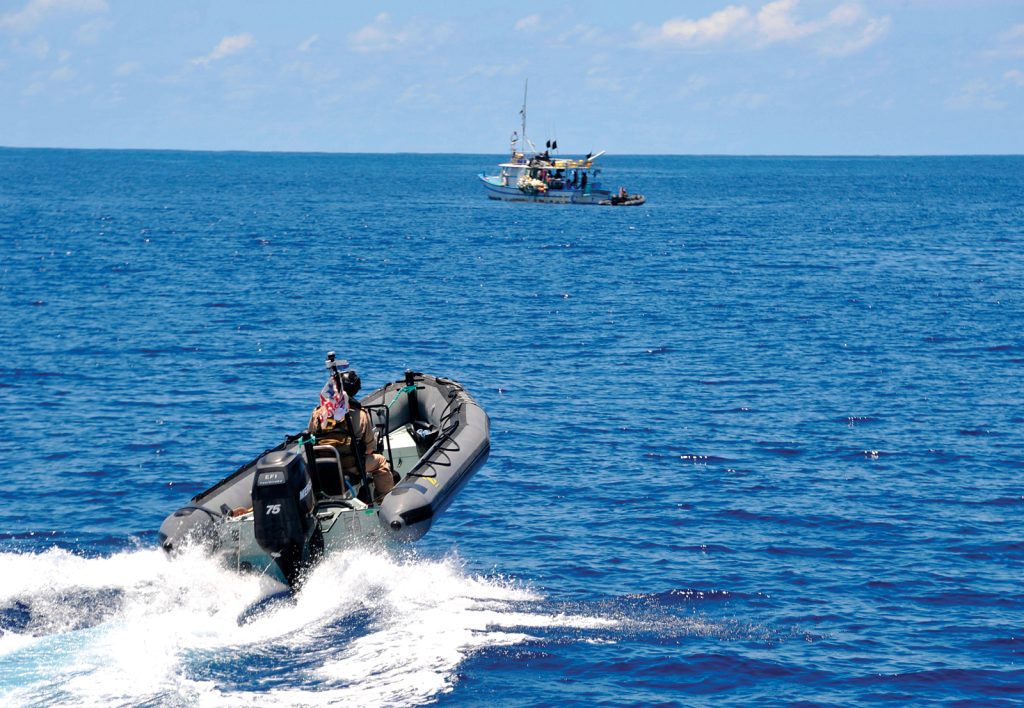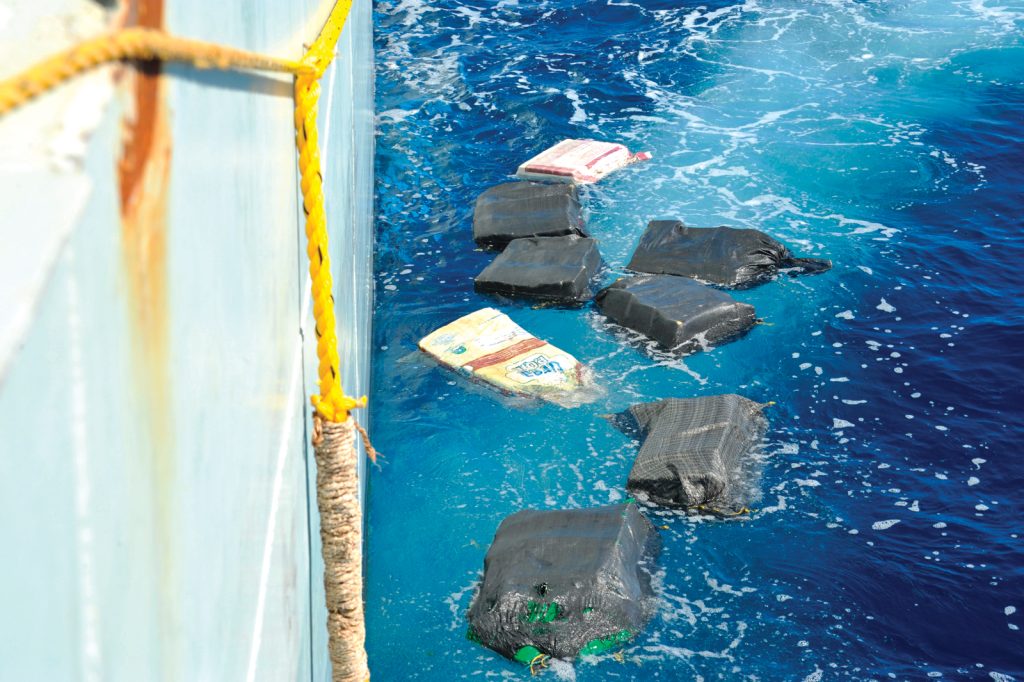Royal Canadian Navy ships seize nearly USD $44M in illicit drugs in support of the U.S. Coast Guard
By Lookout on Apr 19, 2021 with Comments 0

HMCS Saskatoon and the U.S. Coast Guard Southeast Law Enforcement Detachment prepare to intercept a target of interest on March 14.
Captain Sarah Harasymchuk
Operation Caribbe PAO
––
It was Sunday, March 21 at approximately 2:30 p.m. (Central Time). It was quiet on the bridge. The ship was gently making waves, patrolling its assigned area of operations in the eastern Pacific. Suddenly, the radio crackled.
It was a U.S. Navy (USN) P-3 Orion maritime patrol aircraft reporting in. A suspicious “go-fast” vessel was in the area. HMCS Brandon, deployed on Operation Caribbe, was well positioned to make an intercept.
The Officer of the Watch, a Lieutenant (Navy) Naval Warfare Officer immediately took action on the Commanding Officer’s orders to alter course and increase the ship’s speed to intercept the target.
“After I made the pipe to bring the ship to action, all the different parts of the ship’s company instantly came together to close-up on their respective stations,” said the Naval Warfare Officer. “Our success on this interdiction is the result of the expertise and training of the team coming together seamlessly with both Canadian and international partners.”
Brandon quickly launched its two rigid hull inflatable boats (RHIBs) with members of the embarked U.S. Coast Guard (USCG) Law Enforcement Detachment (LEDET) 103, to conduct a Right of Visit boarding.
The Naval Combat Information Operators (NCIOPs) have an important role in the mission, monitoring radio traffic and passing on critical information to the Officer of the Watch on the bridge and the LEDET.
The on-watch NCIOP, a Sailor First Class, describes what happened.
“I started copying the information and confirming the details from the maritime patrol aircraft. As an NCIOP, I am the conduit for all the information coming in and passing it to the key players on the ship. I plotted the latitude and longitude to determine the position of the vessel. Being in the moment was phenomenal and super exciting, to see what actually happens in real-time. I realized this was happening out of nowhere, but I knew what to do because all of my training kicked in.”
When the suspected smugglers detected the approaching law enforcement units, they began jettisoning what appeared to be multiple bales of contraband that were recovered by one of Brandon’s RHIBs. Meanwhile, the second RHIB intercepted the vessel with assistance from USCG Cutter Forward’s helicopter.

HMCS Brandon, in partnership with embarked U.S. Coast Guard Law Enforcement Detachment 103, seized 870 kilograms of cocaine in the eastern Pacific Ocean on March 21.
The USCG helicopter employed Airborne Use of Force on the non-compliant vessel. Warning shots were fired, followed by disabling fire to incapacitate the motors of the vessel and prevent it from fleeing the scene.
The USCG Cutter took custody of three suspected smugglers and 870 kilograms of cocaine, with a street value of approximately USD $33M. The case has now been turned over to the USCG for further action and prosecution by U.S. authorities.
“The ship’s company of Brandon is proud to see mission success on Operation Caribbe in support of our allies, USCG Law Enforcement Detachment 103,” said Lieutenant-Commander Maude Ouellet-Savard, Commanding Officer of Brandon. “This is an example of what the Navy can do for Canada. It’s a mission that demonstrates the Navy’s capability in a tangible way and creates real results that we can all be proud of.”
HMC Ships Brandon and Saskatoon are currently patrolling in the eastern Pacific Ocean on Operation Caribbe to support Joint Interagency Task Force South, which is responsible for the detection and monitoring of illicit trafficking in the eastern Pacific and Caribbean regions.
Operation Caribbe is Canada’s participation in U.S.-led enhanced counter-narcotics operations in the Caribbean Sea and the eastern Pacific Ocean. Under this operation, Canadian Armed Forces ships and aircraft deploy to the region on a rotational basis to help disrupt illicit trafficking in international waters and airspace.
HMCS Saskatoon’s successful intercept
Just two days later, on March 23, the Senior NCIOP on board HMCS Saskatoon, a Master Sailor, logged a target report in the operations room.
“We took immediate action to inform all key players: the Law Enforcement Detachment (LEDET) Chief, the Operations Officer, and the Officer of the Watch. The ship took a new course to steer us in the direction of the target, as we simultaneously readied the boat’s crews and the LEDET 108 for the boarding.”
The target was initially reported by a USN P-3 Orion maritime patrol aircraft operating in the area. Saskatoon’s two RHIBs sped through the waters to intercept the suspected smugglers and the LEDET 108 conducted a Right of Visit boarding. Four suspected smugglers were found on board with contraband that later tested positive for cocaine and marijuana. In total, 250 kg of cocaine and approximately 45 kg of marijuana were seized, valued at nearly USD $11M.
“In all aspects, this success can be credited to each and every member on board Saskatoon. From the communication between the operations room and the key players, the training of the boatswains and LEDET boarding team, to the cooks preparing meals – perseverance and professionalism were displayed throughout the entire evolution, making it a significant, safe and successful mission,” said the Senior NCIOP on board Saskatoon.
The USCG Cutter was then sent to rendezvous with Saskatoon’s location on March 24 to seize the contraband and detain the suspected smugglers. After the suspected smugglers and contraband were removed, their vessel was deemed to be a hazard-to-navigation.
All Royal Canadian Navy ships uphold the international maritime standard to keep the seas safe and are required to destroy any hazard-to-navigation in order to protect mariners worldwide.
The vessel became a hazard-to-navigation and Saskatoon’s Commanding Officer ordered the use of C4 explosives to successfully conduct the first Kingston-class operational demolition, destroying the suspect vessel.
“I am very proud of the crew of Saskatoon, including USCG Law Enforcement Detachment 108, for their tireless efforts throughout Operation Caribbe,” said LCdr Nadia Shields, Commanding Officer of Saskatoon. “It is because of their diligence and professionalism that we have been successful in demonstrating Canada’s interoperability and strong relationships with partner nations. Disrupting the flow of illicit narcotics destined for North America is one way that the Royal Canadian Navy supports Canadians at home.”
––––
Filed Under: Top Stories
About the Author:





